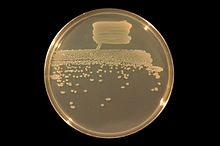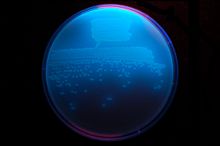- Pseudomonas fluorescens
-
Pseudomonas fluorescens Pseudomonas fluorescens under white light. The same plate under UV light. Scientific classification Kingdom: Bacteria Phylum: Proteobacteria Class: Gamma Proteobacteria Order: Pseudomonadales Family: Pseudomonadaceae Genus: Pseudomonas Species: P. fluorescens Binomial name Pseudomonas fluorescens
(Flügge 1886)
Migula, 1895Type strain ATCC 13525
CCUG 1253
CCEB 546
CFBP 2102
CIP 69.13
DSM 50090
JCM 5963
LMG 1794
NBRC 14160
NCCB 76040
NCIMB 9046
NCTC 10038
NRRL B-14678
VKM B-894Synonyms Bacillus fluorescens liquefaciens Flügge 1886
Bacillus fluorescens Trevisan 1889
Bacterium fluorescens (Trevisan 1889) Lehmann and Neumann 1896
Liquidomonas fluorescens (Trevisan 1889) Orla-Jensen 1909
Pseudomonas lemonnieri (Lasseur) Breed 1948
Pseudomonas schuylkilliensis Chester 1952
Pseudomonas washingtoniae (Pine) ElliottPseudomonas fluorescens is a common Gram-negative, rod-shaped bacterium.[1] It belongs to the Pseudomonas genus; 16S rRNA analysis has placed P. fluorescens in the P. fluorescens group within the genus,[2] to which it lends its name.
Contents
General characteristics
P. fluorescens has multiple flagella. It has an extremely versatile metabolism, and can be found in the soil and in water. It is an obligate aerobe, but certain strains are capable of using nitrate instead of oxygen as a final electron acceptor during cellular respiration.
Optimal temperatures for growth of Pseudomonas fluorescens are 25-30 degrees Celsius. It tests positive for the oxidase test. Pseudomonas fluorescens is also a nonsaccharolytic bacteria.
Heat-stable lipases and proteases are produced by Pseudomonas fluorescens and other similar pseudomonads.[3] These enzymes cause milk to spoil, by causing bitterness, casein breakdown, and ropiness due to production of slime and coagulation of proteins.[4][5]
The name
The word Pseudomonas means 'false unit', being derived from the Greek words pseudo (Greek: ψευδο 'false') and monas (Latin: monas, fr. Greek: μονάς/μονάδα 'a single unit'). The word was used early in the history of microbiology to refer to germs. The name 'fluorescens' refers to the microbe's secretion of a soluble fluorescent pigment called pyoverdin (formerly called fluorescein), which is a type of siderophore.[6]
Genome sequencing projects
The genomes of P. fluorescens strains SBW25,[7] Pf-5[8] and PfO-1[9] have been sequenced.
Biocontrol properties
Some P. fluorescens strains (CHA0 or Pf-5, for example) present biocontrol properties, protecting the roots of some plant species against parasitic fungi such as Fusarium or Pythium, as well as some phytophagous nematodes.[10]
It is not clear exactly how the plant growth-promoting properties of P. fluorescens are achieved; theories include:
- the bacteria might induce systemic resistance in the host plant, so it can better resist attack by a true pathogen
- the bacteria might outcompete other (pathogenic) soil microbes, e.g., by siderophores, giving a competitive advantage at scavenging for iron
- the bacteria might produce compounds antagonistic to other soil microbes, such as phenazine-type antibiotics or hydrogen cyanide
To be specific, certain P. fluorescens isolates produce the secondary metabolite 2,4-diacetylphloroglucinol (2,4-DAPG), the compound found to be responsible for antiphytopathegenic and biocontrol properties in these strains.[11] The phl gene cluster encodes factors for 2,4-DAPG biosynthesis, regulation, export, and degradation. Eight genes, phlHGFACBDE, are annotated in this cluster and conserved organizationally in 2,4-DAPG-producing strains of P. fluorescens. Of these genes, phlD encodes a type III polyketide synthase, representing the key biosynthetic factor for 2,4-DAPG production. PhlD shows similarity to plant chalcone synthases and has been theorized to originate from horizontal gene transfer.[12] But phylogenetic and genomic analysis has revealed that the entire phl gene cluster is ancestral to P. fluorescens, many strains have lost the capacity, and it exists on different genomic regions among strains.[13]
There is experimental evidence to support all of these theories, in certain conditions; a good review of the topic is written by Haas and Defago.[14]
The strain referred to as Pf-CL145A has proved itself a promising solution to the invasive Dreissena( zebra and quagga) mussels. The strain of the bacteria produces toxins that destroy the digestive system of the mussels and produces a >90% kill rate.
Several strains of "P. Fluorescens", such as Pf-5 and JL3985, have developed a natural resistance to ampicillin and streptomycin[15]. These antibiotics are regularly used in biological research as a selective pressure tool to promote plasmid expression.
Medical Properties
By culturing Pseudomonas fluorescens, Mupirocin (an antibiotic) can be produced, which has been found to be useful in treating skin, ear, and eye disorders.[16] Mupirocin free acid and its salts and esters are agents currently used in creams, ointments, and sprays as a treatment of Methicillin-resistant Staphylococcus aureus (MRSA) infection.
P. fluorescens demonstrates hemolytic activity and, as a result, has been known to infect blood transfusions.[17]
It is also used in milk to make yogurt.
United States Patents: 6489358, 4873012, 6156792
Disease
P. fluorescens is an unusual cause of disease in humans, and usually affects patients with compromised immune systems (e.g., patients on cancer treatment). From 2004 to 2006, there was an outbreak of P. fluorescens in the United States, involving 80 patients in six states. The source of the infection was contaminated heparinized saline flushes being used with cancer patients.[18]
References
- ^ Palleroni, N.J. (1984) Pseudomonadaceae. Bergey's Manual of Systematic Bacteriology. Krieg, N. R. and Holt J. G. (editors) Baltimore: The Williams and Wilkins Co., pg. 141 - 199
- ^ Anzai, et al.; Kim, H; Park, JY; Wakabayashi, H; Oyaizu, H (2000, Jul). "Phylogenetic affiliation of the pseudomonads based on 16S rRNA sequence". Int J Syst Evol Microbiol 50 (Pt 4): 1563–89. doi:10.1099/00207713-50-4-1563. PMID 10939664.
- ^ Frank, J.F. 1997. Milk and dairy products. In Food Microbiology, Fundamentals and Frontiers, ed. M.P. Doyle, L.R. Beuchat, T.J. Montville, ASM Press, Washington, p. 101.
- ^ Jay, J.M. 2000. Taxonomy, role, and significance of microorganisms in food. In Modern Food Microbiology, Aspen Publishers, Gaithersburg MD, p. 13.
- ^ Ray, B. 1996. Spoilage of Specific food groups. In Fundamental Food Microbiology, CRC Press, Boca Raton FL, p. 220. I
- ^ C D Cox and P Adams (1985) Infection and Immunity 48(1): 130–138
- ^ Pseudomonas fluorescens
- ^ Pseudomonas fluorescens Pf-5 Genome Page
- ^ Pseudomonas fluorescens PfO-1 Genome Page
- ^ Haas, D. and Keel, C. (2003) Regulation of antibiotic production in root-colonizing Pseudomonas spp. and relevance for biological control of plant disease. Annual Reviews of Phytopathology 41, 117-153 PMID 12730389
- ^ Bangera, M. G., and L. S. Thomashow. 1999. Identification and characterization of a gene cluster for synthesis of the polyketide antibiotic 2,4-diacetylphloroglucinol from pseudomonas fluorescens q2-87. Journal of Bacteriology 181:3155-3163.
- ^ Bangera, M. G., and L. S. Thomashow. 1999. Identification and characterization of a gene cluster for synthesis of the polyketide antibiotic 2,4-diacetylphloroglucinol from pseudomonas fluorescens q2-87. Journal of Bacteriology 181:3155-3163.
- ^ Moynihan, J. A., J. P. Morrissey, E. R. Coppoolse, W. J. Stiekema, F. O'Gara, and E. F. Boyd. 2009. Evolutionary history of the phl gene cluster in the plant-associated bacterium pseudomonas fluorescens. Applied and Environmental Microbiology 75:2122-2131.
- ^ Haas D, Defago G. (2005) Biological control of soil-borne pathogens by fluorescent pseudomonads. Nature Reviews in Microbiology 3(4):307-19 doi:10.1038/nrmicro1129 PMID 15759041
- ^ Alain Sarniguet et al. (1995). "The sigma factor σs affects antibiotic production and biological control activity of Pseudomonas fluorescens Pf-5". P Natl Aca Sci USA 92: 12255–12259.
- ^ Bactroban
- ^ Gibb AP, Martin KM, Davidson GA, Walker B, Murphy WG. (1995) Rate of growth of Pseudomonas fluorescens in donated blood. Journal of Clinical Patholology 48(8):717-8. PMID 7560196
- ^ Gershman MD, Kennedy DJ, Noble-Wang J, et al. (2008). "Multistate outbreak of Pseudomonas fluorescens bloodstream infection after exposure to contaminated heparinized saline flush prepared by a compounding pharmacy". Clin Infect Dis 47 (11): 1372–1379. doi:10.1086/592968. PMID 18937575.
External links
- www.pseudomonasfluorescens.org
- www.pseudomonas.com, the Pseudomonas genome database
- Migula's Systematic Bacteriology (in German)
- UV fluorescent Pseudomonas video
- [1]
Categories:
Wikimedia Foundation. 2010.


